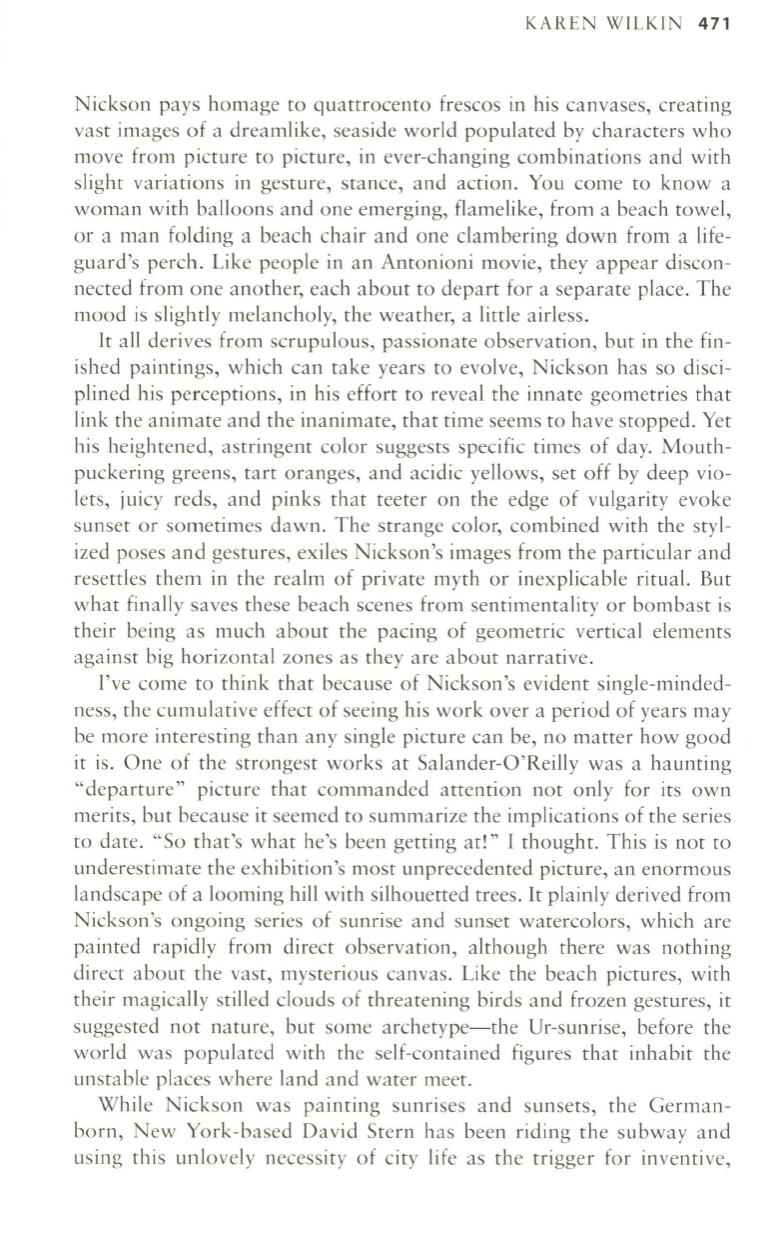
KAREN WILKIN
471
Nickson pays homage to quattrocento frescos in his canvases, creating
vast images of a dreamlike, seaside world populated by characters who
move from picture to picture, in ever-changing combinations and with
slight variations in gesture, stance, and action. You come to know a
woman with balloons and one emerging, flamelike, from a beach towel,
or a man folding a beach chair and one clambering down from a life–
guard's perch. Like people in an Antonioni movie, they appear discon–
nected from one another, each about to depart for a separate place. The
mood is slightly melancholy, the weather, a little airless.
It
all derives from scrupulous, passionate observation, but in the fin–
ished paintings, which can take years to evolve, Nickson has so disci–
plined his perceptions, in his effort to reveal the innate geometries that
link the animate and the inanimate, that time seems to have stopped. Yet
his heightened, astringent color suggests specific times of day. Mouth–
puckering greens, tart oranges, and acidic yellows, set off by deep vio–
lets, juicy reds, and pinks that teeter on the edge of vulgarity evoke
sunset or sometimes dawn. The strange color, combined with the styl–
ized poses and gestures, exiles Nickson's images from the particular and
resettles them in the realm of private myth or inexplicable ritual. But
what finally saves these beach scenes from sentimentality or bombast is
their being as much about the pacing of geometric vertical elements
against big horizontal zones as they are about narrative.
I've come to think that because of Nickson's evident single-minded–
ness, the cumulative effect of seeing his work over a period of years may
be more interesting than any single picture can be, no matter how good
it is. One of the strongest works at Salander-O'Reilly was a haunting
" departure" picture that commanded attention not only for its own
merits, but because it seemed to summarize the implications of the series
to date. "So that's what he's been getting at!" I thought. This is not to
underestimate the exhibition's most unprecedented picture, an enormous
landscape of a looming hill with silhouetted trees. It plainly derived from
Nickson's ongoing series of sunrise and sunset watercolors, which are
painted rapidly from direct observation, although there was nothing
direct about the vast, mysterious canvas. Like the beach pictures, with
their magically stilled clouds of threatening birds and frozen gestures, it
suggested not nature, but some archetype-the Ur-sunrise, before the
world was populated with the self-contained figures that inhabit the
unstable places where land and water meet.
While Nickson was painting sunrises and sunsets, the German–
born, New York-based David Stern has been riding the subway and
using this unlovely necessity of city life as the trigger for inventive,


